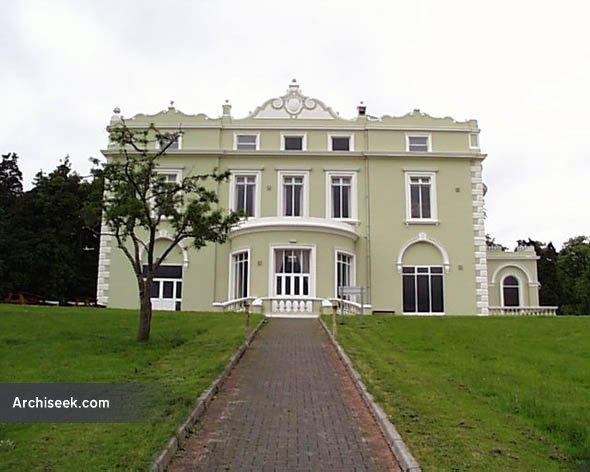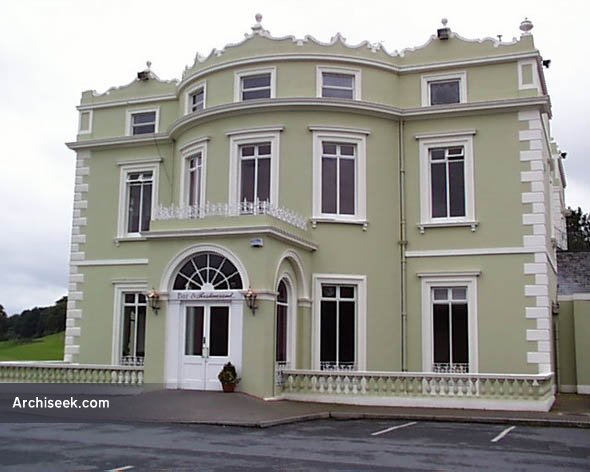SIR EDWARD BLAYNEY (1570-1629), Knight, a native of Wales, said to be descended from Cadwallader, King of Cambria and a younger son of the Prince of Wales, had been employed from his youth in the armies of ELIZABETH I. He accompanied Robert, Earl of Essex, as Colonel, into Ireland, 1598, where he obtained both wealth and renown in the subsequent wars.
Sir Edward, Governor of
Monaghan, was granted the thirty-two townlands of Ballynalurgan and in
1611 he obtained the termon of Muckno as well.
Blayney
built a castle, around which a Planter village soon began to develop.
This was the origin of the present town of Castleblayney.
Sir Edward married Anne, second daughter of the Most Rev Dr Adam Loftus, Lord Archbishop of Dublin, CHANCELLOR OF IRELAND, by whom he had, with six daughters, two sons,
HENRY (Sir), his successor;
ARTHUR (Sir), of Castle Shane.
Sir Edward was elevated to the peerage by JAMES I, in 1621, in the dignity of BARON BLAYNEY, of Monaghan.
His lordship was succeeded by his elder son,
HENRY, 2nd Baron, who wedded, in 1623, Jane, daughter of Gerald, Viscount Drogheda, by whom he had two surviving sons and five daughters.
His lordship, who was a military man, was slain at the battle of Benburb, County Tyrone, 1646, and was succeeded by his elder son,
His lordship, who was a military man, was slain at the battle of Benburb, County Tyrone, 1646, and was succeeded by his elder son,
EDWARD, 3rd Baron (c1625-69), who died unmarried, and was succeeded by his brother,
RICHARD, 4th Baron (c1625-70), who was high in favour with CROMWELL, and had been appointed, in 1656, the usurper's custos-rotulorum of County Monaghan, and escheator of County Tyrone.
His lordship espoused firstly, in 1653, Elizabeth, eldest daughter of Mr Alderman Vincent, of Dublin, MP, by whom he had several children; and secondly, Jane, daughter of John Malloch.
His lordship was succeeded by his eldest son,
HENRY VINCENT, 5th Baron, who wedded Margaret Moore, eldest sister of John, 1st Lord Tullamore, by whom he had an only surviving child, Elinor.
His lordship fled Castleblayney at the outbreak of the Williamite wars and was chosen as commander-in-chief of the Protestant forces raised to defend Monaghan and Armagh against JAMES II, who transmitted it to his brother,
His lordship espoused firstly, in 1653, Elizabeth, eldest daughter of Mr Alderman Vincent, of Dublin, MP, by whom he had several children; and secondly, Jane, daughter of John Malloch.
His lordship was succeeded by his eldest son,
HENRY VINCENT, 5th Baron, who wedded Margaret Moore, eldest sister of John, 1st Lord Tullamore, by whom he had an only surviving child, Elinor.
His lordship fled Castleblayney at the outbreak of the Williamite wars and was chosen as commander-in-chief of the Protestant forces raised to defend Monaghan and Armagh against JAMES II, who transmitted it to his brother,
WILLIAM, 6th Baron, who married, in 1686, Mary, eldest daughter of William, 1st Viscount Charlemont, and dying in 1705, was succeeded by his only surviving son,
CADWALLADER, 7th Baron (1693-1732), who married Mary, daughter of the Hon John Tucket, and niece of Charles, Duke of Shrewsbury, Lord Lieutenant of Ireland, and had issue.
His lordship espoused secondly, Mary, daughter and heiress of Sir Alexander Cairnes Bt, of Monaghan.
His lordship was succeeded by his eldest son,
His lordship espoused secondly, Mary, daughter and heiress of Sir Alexander Cairnes Bt, of Monaghan.
His lordship was succeeded by his eldest son,
THE VERY REV CHARLES TALBOT, 8th Baron (1714-61), Dean of Killaloe, at whose decease, without surviving issue, the title devolved upon his brother,
CADWALLADER, 9th Baron (1720-75), who married, in 1767, Sophia, daughter of Thomas Tipping, of Beaulieu, and had issue,
CADWALLADER DAVIS, his successor;
ANDREW THOMAS, succeeded his brother;
Sophia; Mary.
His lordship, a lieutenant-general in the army, was succeeded by his elder son,
CADWALLADER DAVIS, 10th Baron (1769-84); at whose decease, unmarried, the title reverted to his brother,
ANDREW THOMAS, 11th Baron (1770-1834), a lieutenant-general in the army, who wedded, in 1796, Mabella, eldest daughter of James, 1st Earl of Caledon, and had issue,
CADWALLADER DAVIS, his successor;
Anne; Charlotte Sophia.
His lordship was succeeded by his son,
CADWALLADER DAVIS, 12th Baron (1802-74), MP for County Monaghan, 1830-34, at whose decease, unmarried, the title expired.
The Caledon Connection
The Blayney/Hope Papers are deposited at PRONI.The Caledon estate in County Tyrone is just a few fields away from that of the Leslies in Glaslough, County Monaghan, and the Earls of Caledon themselves owned some land in County Monaghan.Because of the family connection between the lst and 2nd Earls and the 11th Lord Blayney, who was their son-in-law and brother-in-law respectively, the correspondence between Blayney and the two earls yields a lot of information about his military and political careers; for example, the siege of Alexandria and as a prisoner of war in Napoleonic France.During Blayney's long incarceration, the 2nd Earl of Caledon looked after his financial, domestic, and political affairs, thus being drawn into the Monaghan sphere.This brought political figures such as Dawson and Leslie beating a path to Caledon's door, because during this period he was the representative of Blayney and 'the Blayney interest'.On his return, Blayney was given a seat in parliament for Caledon's infamous 'rotten borough' of Old Sarum, Wiltshire. Later, he attempted to get Caledon to use his influence with the Government to get him elected an Irish Representative Peer.This yields a very illuminating and often pained correspondence between the two men.
HOPE CASTLE, Castleblayney, County Monaghan, formerly known as Blayney Castle after the plantation castle nearby (from
which the town gets its name), has had many owners and uses
over the years.
Originally a three storey, five bay Georgian block, the
house received many embellishments during the Victorian era including
scrolled cresting on the roof parapets and at one stage an ornamental
cast iron and glass porch canopy.
In 1853, Cadwaller, 12th and last Lord Blayney, sold the Castle and estate to Henry Thomas Hope from Deepdene in Surrey, a former MP at Westminster.
Thereafter the Castle was renamed Hope Castle, as it still called.
Hope gave the Georgian Castle with its splendid prospect a Victorian makeover that the present building retains, externally at least.
After his death in 1862, Hope's wife Anne inherited the estate.
Soon after 1887, the Castle and demesne fell to the next heir, a grandson of Hope: Lord Henry Francis Hope Pelham-Clinton-Hope, famous for having sold the renowned family heirloom, the Hope Diamond.
From 1900 until 1904, the Castle became the residence of Field-Marshal HRH The Duke of Connaught, Commander-in-Chief, Ireland.
After 1916, Lord Henry no longer resided in the Castle nor in Ireland.
On becoming 8th Duke of Newcastle in 1928, he later sold both the Castle and the estate, which was broken up and used in part for local political patronage.
On becoming 8th Duke of Newcastle in 1928, he later sold both the Castle and the estate, which was broken up and used in part for local political patronage.
In 1919-21, the Castle was used as a barracks by the British Army.
Some time afterwards it functioned as a hospital; and from 1943-74, it was occupied by Franciscan nuns who also managed an adjacent guest house.
Some time afterwards it functioned as a hospital; and from 1943-74, it was occupied by Franciscan nuns who also managed an adjacent guest house.
After some years of neglect, the Castle has been used for catering and hotel purposes set in what is now a Leisure Park with golf course.
In October 2010, the Castle was burnt down in an arson attack.
The building has suffered greatly during its lifetime – after being
an convent, it remained empty for many years and was taken over the the
local County Council who demolished the 19th century additions to the
garden and main fronts and renovated the building.
Its most interesting
internal feature – a Soanesque top-lit upper stair landing, was destroyed
during the building’s phase of dereliction.
The estate still has a good
stable-yard and cast-iron gateway with matching gatehouses.
First published in July, 2012.
First published in July, 2012.





2 comments :
I visited the castle only three years ago and was very shocked by the state of the building especially as I have traced back my family tree and in fact my Grandfather was born in 1883 bearing the surname of Blayney and his grandfather was in fact the 12th baron Edward Blayney. I have still got the 2 books written by him about the Spanish Civil war along with a letter from the Duchess of Devonshire which is a complete mystery. Any information would be of interest. rob@blayneypartnership.co.uk
I'd like to know if this Blayney family are connected to the Blamey family of Cornwall.
Lisa
Lisawilson0210@gmail.com
Post a Comment